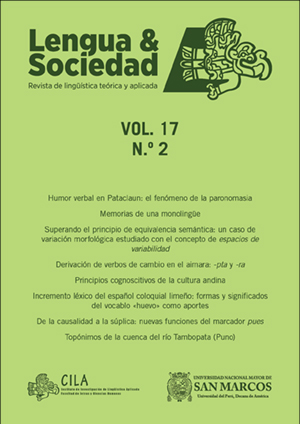Topónimos de la cuenca del río Tambopata (Puno)
DOI:
https://doi.org/10.15381/lengsoc.v17i2.22357Palabras clave:
Aimara, Tambopata, variación dialectal, toponimiaResumen
En este artículo presentamos los topónimos de la cuenca del río Tambopata en la región de Puno. Constituye solo una parte del estudio más amplio que hemos realizado sobre el léxico de nombres de lugares, plantas, animales, enfermedades y objetos recogidos en la cuenca del río Tambopata que comprende en su recorrido a tres distritos de la Prov. de Sandia: Yanahuaya, San Juan del oro y Putina Punco. Se analizó lingüísticamente (fonología, léxico y semántica) la variación de los nombres que están relacionados con la lengua que hablan en la zona. Así mismo, se aplicó la teoría de la variación dialectal y el método de geografía lingüística o geolingüística para levantar isoglosas, con un enfoque descriptivo – interpretativo inspirado en la lingüística estructural y funcional.
Se ha probado la hipótesis planteada, que el abandono de la lengua y cultura es lenta. El objetivo del estudio es mostrar la dialectalización del aimara y los patrones de denotación y connotación. Este estudio servirá para elaborar la cartografía lingüística, diccionarios regionales. Así también contribuirá con el conocimiento de los saberes andinos que está presente en este avance cultural, asimismo fortalecerá la interculturalidad.
Referencias
Calizaya, J. (2006). EL Alto Tambopata. Puno, Perú: Speedy & Service Pacific.
Carbajal, F. (1908). Expedición al Tambopata. Boletín de la Sociedad Geográfica de Lima, Tomo 23-4, 277-298.
Chichon, A. (1977). La lenta colonización del inambari y el Tambopata: Uso del espacio en la Selva Sur del Perú. En Perú, Problema Agrario. Lima, Perú: Sepia.
Guevara, A. (1955). Apuntes sobre mi Patria (Tomo 3). Lima: H. G. Rozas
Huayhua, F. (2009). Diccionario Bilingüe polilectal Aimara – Castellano – Aimara. Lima, Perú: Universidad Nacional Mayor de San Marcos.
Luna, M. (1954). La Colonización indígena del Valle de Tambopata. Lima, Perú: Dir. De Asuntos Indígenas.
Martínez, H. (1969). Las migraciones altiplánicas y la colonización del Tambopata. Lima, Perú: Centro de Estudios de Población.
Metraux, A. (1954). Informe sobre emigración interna y externa de los indios aymaras en el Valle de Tambopata. Ginebra: OIT.
Raimondi, A. (1910). Itinerario de los viajes de Raimondi. Boletín de la Sociedad Geográfica de Lima, Tomo 25–3, 65-108.
Stiglich, G. (1908). Viaje de Sandia a Chunchosmayo. En Boletín de la Sociedad Geográfica de Lima, Tomo 33–41, 355-393.
Torres, A. (1968). La meseta y el Lago Titicaca. Lima: Gráfica Colegio Unión.
Turpo, R. (2010). Monografía 1. Centro poblado de Yanamayo Sandia. Puno, Perú: Radio FM San Gabriel, Parroquia Santa Rosa de Lima.
Villalta, J. (1907). Expedición al Tambopata. Boletín de la Sociedad Geográfica de Lima, Tomo 21–4, 440-458.
Descargas
Publicado
Número
Sección
Licencia
Derechos de autor 2018 Felipe Huayhua Pari

Esta obra está bajo una licencia internacional Creative Commons Atribución 4.0.
LOS AUTORES RETIENEN SUS DERECHOS:
a. Los autores retienen sus derechos de marca y patente, y también sobre cualquier proceso o procedimiento descrito en el artículo.
b. Los autores pueden presentar a la revista Lengua y Sociedad, trabajos difundidos como pre-print en repositorios. Esto debe hacerse conocer en la carta de presentacion del trabajo.
c. Los autores retienen el derecho de compartir, copiar, distribuir, ejecutar y comunicar públicamente el artículo publicado en la revista Lengua y Sociedad (por ejemplo, colocarlo en un repositorio institucional o publicarlo en un libro), con un reconocimiento de su publicación inicial en la revista Lengua y Sociedad.
d. Los autores retienen el derecho a hacer una posterior publicación de su trabajo, de utilizar el artículo o cualquier parte de aquel (por ejemplo: una compilación de sus trabajos, notas para conferencias, tesis, o para un libro), siempre que indiquen su publicación inicial en la revista Lengua y Sociedad (autores del trabajo, revista, volumen, número y fecha).






